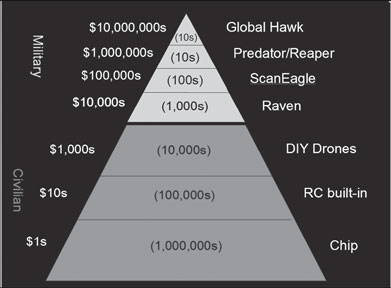A new frontier in aviation
  Even a decade ago, most people simply had no idea what a drone was.
Now, there is hardly anyone who does not know. In just a few years,
Unmanned Aerial Vehicles (UAVs), commonly called drones, have literally
gone a great distance. Even a decade ago, most people simply had no idea what a drone was.
Now, there is hardly anyone who does not know. In just a few years,
Unmanned Aerial Vehicles (UAVs), commonly called drones, have literally
gone a great distance.
Drones are a great help in combat situations, especially in
localities where it may not be possible to send manned aircraft or
ground troops. This was indeed the case in Sri Lanka, where UAVs played
a major role in intelligence gathering. Drones are also used in targeted
attacks against identified places and individuals.
Like almost all military technologies, drones too have found their
way to civilian hands. While the military drones have such as Predator,
civilian drones have benign names such as Watchkeeper. As the technology
becomes cheaper, manufacturers can sell civilian versions for a fraction
of the cost of military versions. In the US alone, the Federal Aviation
Administration estimates that around 7,500 drones will be in operation
by 2018. Other developed and even developing countries will not be far
behind in the drone race.
This has given rise to a huge debate around the world, with
proponents and opponents of civilian drones battling it out in the open.
Nevertheless, civilian drones are here to stay. The only question is
whether their use should be regulated and restricted at government level
in the interest of safety and privacy.
Concerns
These are quite real and legitimate concerns. Even with a rudimentary
model plane fitted with a camera, a nosey neighbour can peek into the
goings-on in his neighbourhood. The possibilities for invading the
privacy of individuals using more sophisticated drones are much higher.
There is also the possibility that rival companies could spy on each
other using commercial drones.
 |
|
Chart showing the relationship between
“drone/autopilot production volume
and price.” |
Another nightmare scenario is the possible use of drones by terrorist
and insurgent groups. It is not beyond their means to fit some sort of
destructive weapon to a drone either. This is an eventuality that all
governments want to avoid.
Those are some of the cons. How about the pros? Drones will be very
useful in times of natural disasters for fast data gathering and damage
assessment especially if some of the affected areas cannot be reached
easily. Drones can facilitate the work of rescue and relief teams in
these circumstances.
They are also becoming useful for agriculture, spraying water and
chemicals (some of which are hazardous)on to farmlands. Drones are also
used to examine oil pipelines, oil rigs and other infrastructure for any
structural flaws. Greenpeace recently purchased two advanced UAVs to
monitor the Arctic, which is another example for the versatility of
drones. They are also being used to shoot commercials and movies and
track wildlife.
The low operating cost is another plus point. A drone can be in the
air for as little as Rs.400 per hour, whereas a manned helicopter or
plane costs many times more. At a time when most countries are cutting
police budgets, this sounds like good news for law enforcement agencies.
Traffic
If the drone industry has its way, our skies could soon be buzzing
with drones. This raises the question of regulating drone traffic in
much the same way as air traffic. With so many of them flying about,
there could be collisions and crashes. Some drones are robotic ones that
can have a measure of independence and decision-making, but we cannot
expect all drones to be intelligent in that sense of the word. There is
usually a human on the ground who remotely commands the UAV. A mechanism
should be evolved to make the skies friendlier and accident-free for all
drones.
When the first mobile phones with cameras were unveiled, there was
panic everywhere on the grounds that they could invade your privacy.
Today, every mobile phone has an advanced camera and a video recorder.
No one even talks about them anymore - they have become everyday devices
we take for granted, privacy concerns notwithstanding. Over time, the
same is likely to happen with drones.
Drones are the next frontier of innovation. If the industry is over
regulated and stifled, we might miss out on bigger innovations in the
sector - innovations that can make a difference to our lives.
Governments, user groups and manufacturers should thus get together and
create standards that define their uses without restricting the
expansion of the drone industry.
|


